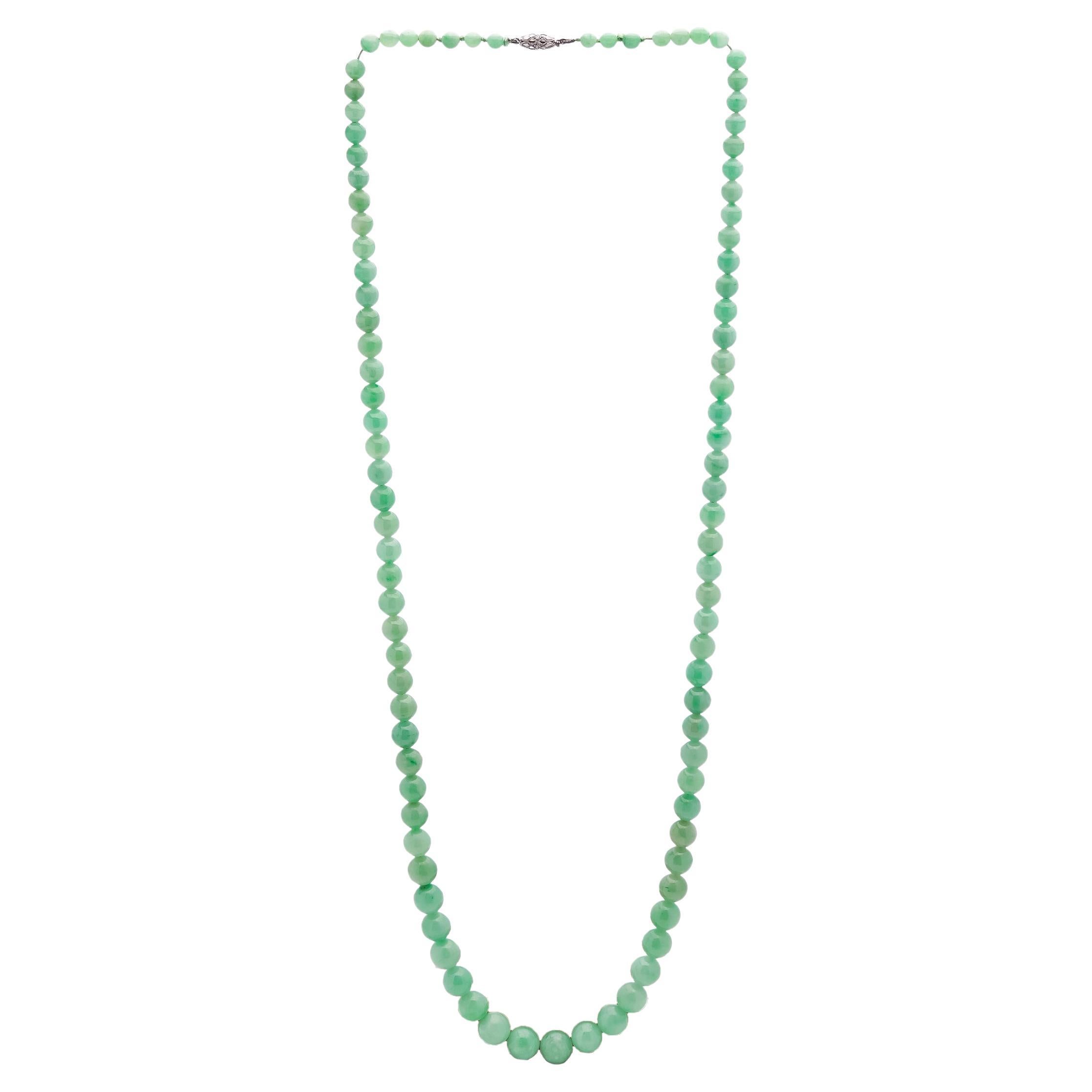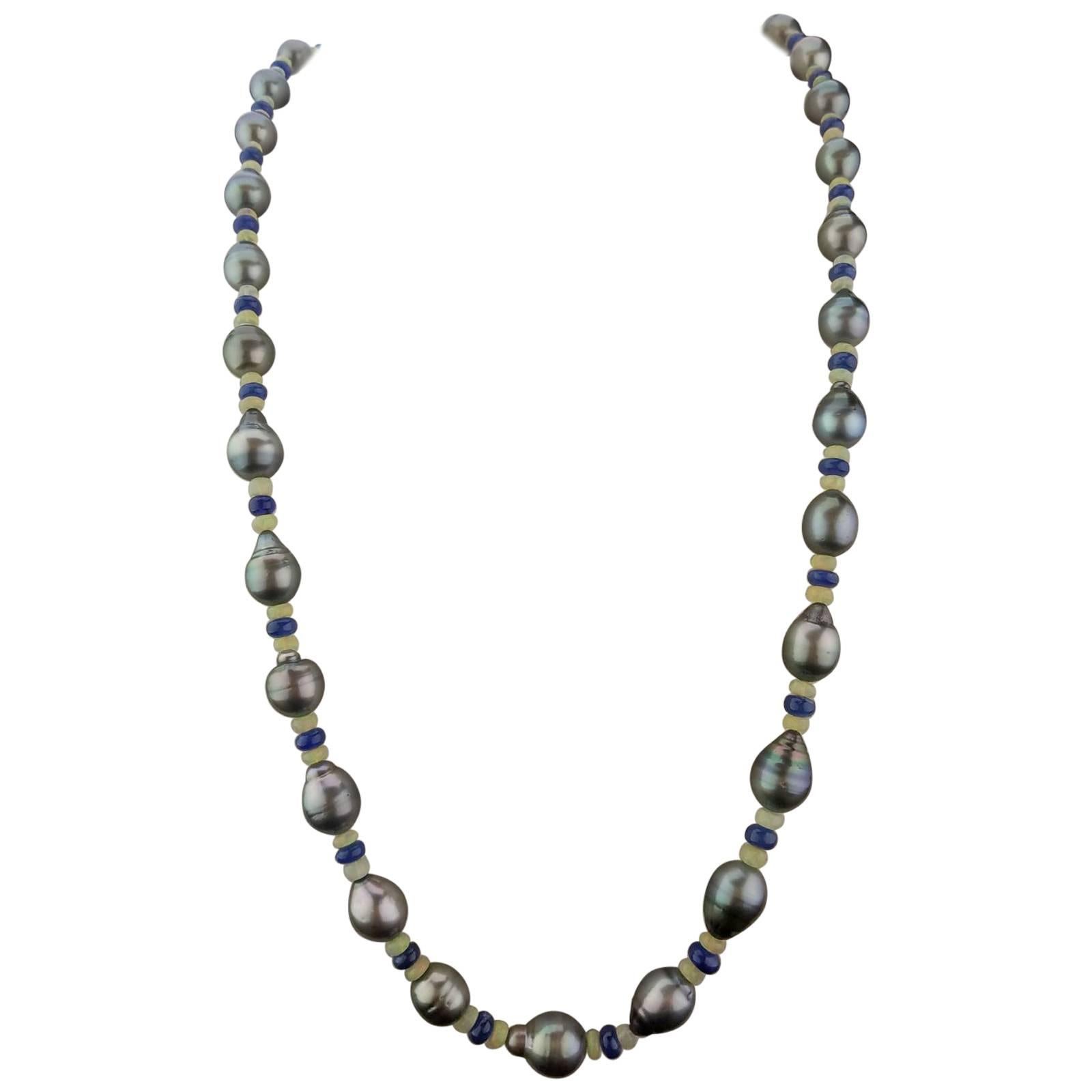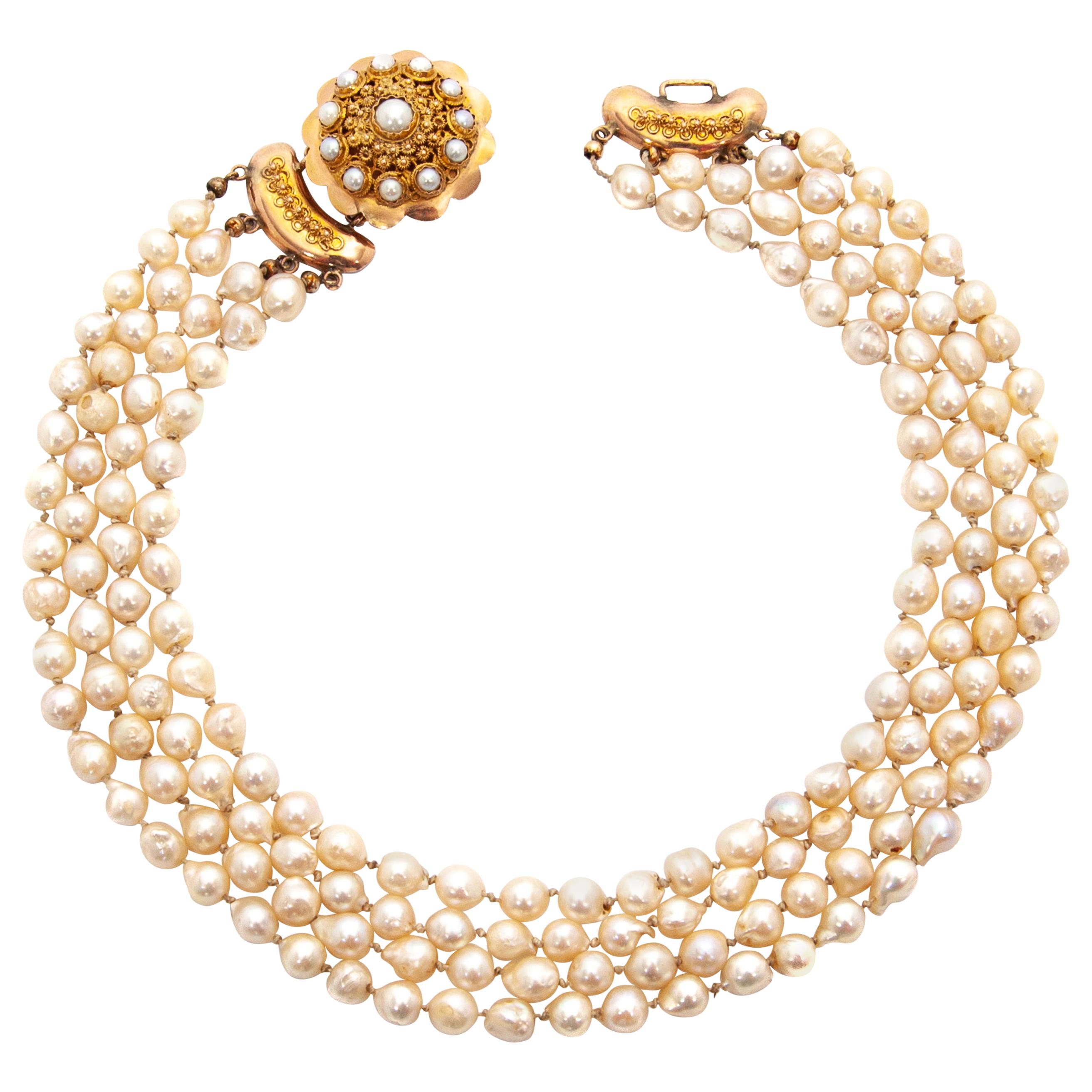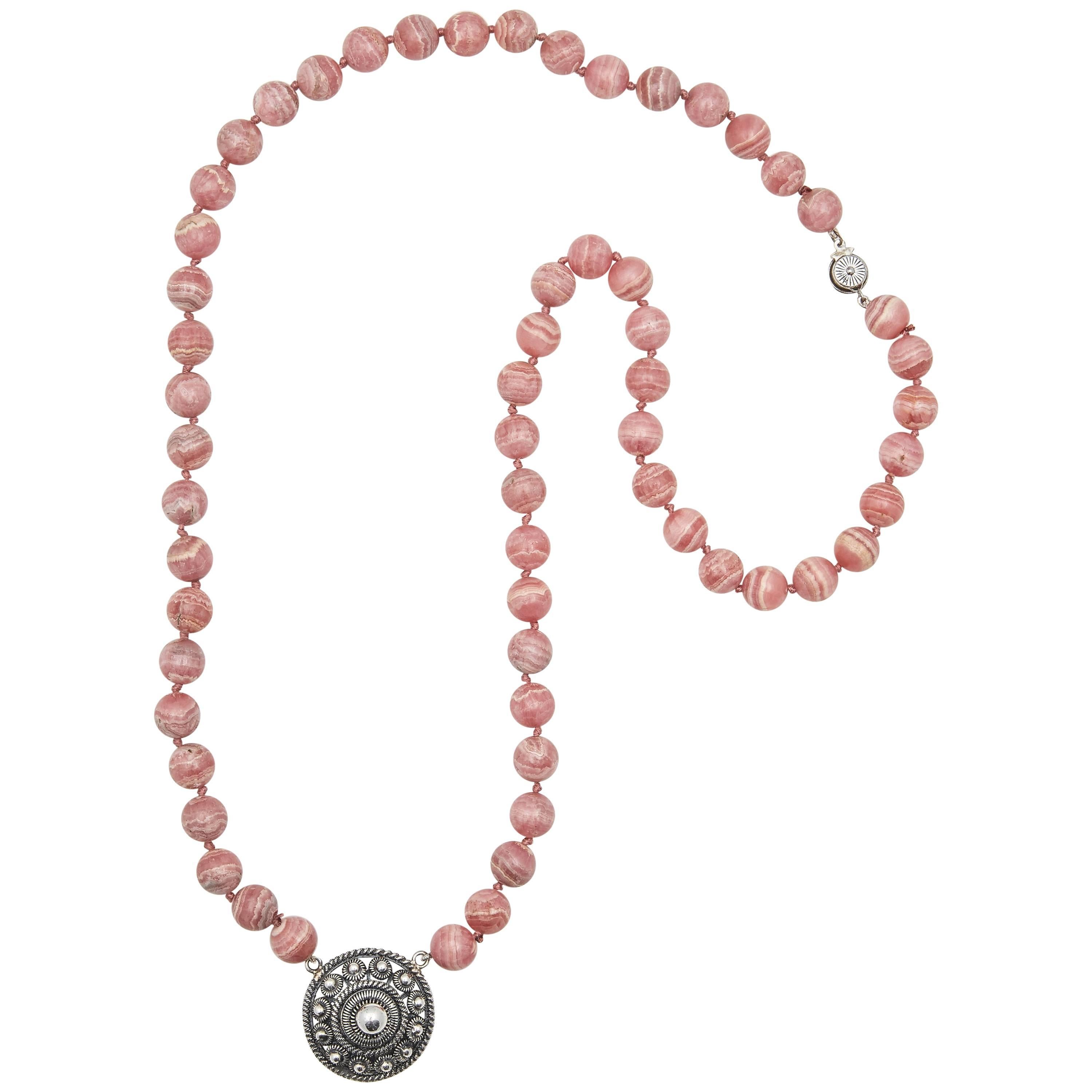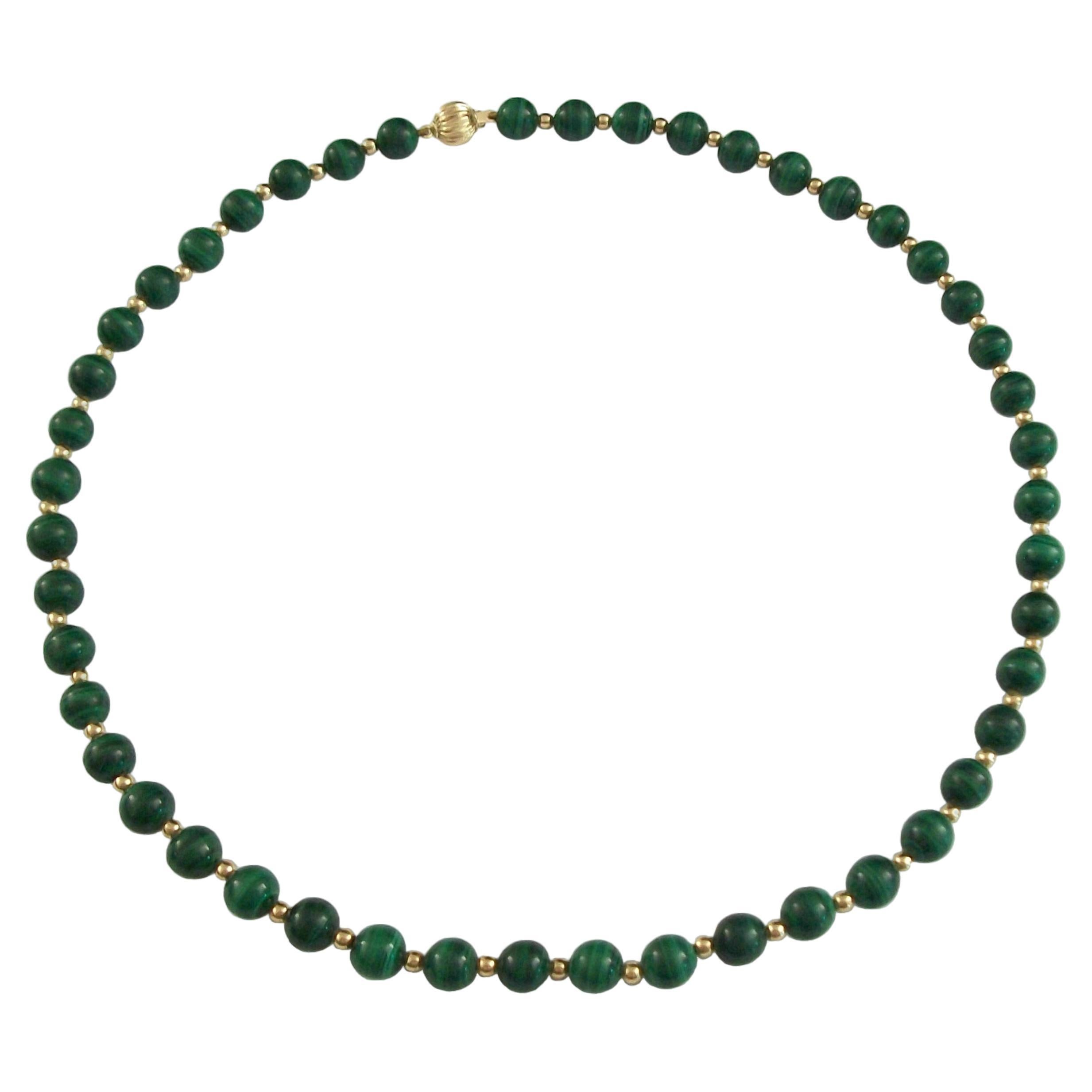Items Similar to Antique early 20th century opal bead and pearl necklace
Want more images or videos?
Request additional images or videos from the seller
1 of 7
Antique early 20th century opal bead and pearl necklace
About the Item
42 beautiful, gently graduated, multi-chromatic opal beads imbued with lightening flashes, alternate with small even sized pearls to create this enchanting necklace. The beads are ranging from 5 millimeters to impressive 13 mm millimeters. It is very difficult to find opal blocks thick enough to create such large beads.
The graduated gems are an impressive size and perfectly matched, with each exhibiting a high level of translucence and a consistent palette of vibrant colors with a burning orange sunset glowing behind. A simple platinum oval-shape clasp set with an oval opal seals the deal of this mesmerizing necklace.
Opals are not cut into beads very often, as they are usually found in thin layers, and bigger deposits are exceptionally rare. Cutting the round structure also creates a great deal of excess– about 90% of the rough opal is cut away to create just one bead. To find 42 matching beads of this size takes a serious effort.
Opal is the birthstone of October.
Truly the stuff of fairy tales. Their magic has been revered throughout history. Queen Victoria counted opal as her most favorite gem.
Many cultures have imbued opals with supernatural origins and powers. Arabic folklore tell that it falls from the heavens in flashes of lightning. In ancient Greece it was said htat opals gave their owners the gift of prophecy and guarded them from disease.
The romans believed opals was the source of good fortune and classified it as a precious gemstone. In western Europe opals have long been considered as a symbol of hope, purity, and truth. The opal has ever since its discovery taken it’s place front stage when it can. It is part of the crown jewels of many nations, including the Holy Roman Empire, France and England.
21" length
Materials:
18karat gold and platinum
Gram Weight:
38,9 grams
Period:
Late Victorian
Wear consistent with age and use. A couple of the opals show light crazing.
- Metal:
- Stone:
- Stone Cut:
- Weight:38.9 g
- Dimensions:Length: 20 in (508 mm)
- Style:
- Place of Origin:
- Period:
- Date of Manufacture:1900
- Condition:Wear consistent with age and use.
- Seller Location:Malmö, SE
- Reference Number:1stDibs: LU3148222494752

About the Seller
5.0
Recognized Seller
These prestigious sellers are industry leaders and represent the highest echelon for item quality and design.
Platinum Seller
These expertly vetted sellers are 1stDibs' most experienced sellers and are rated highest by our customers.
Established in 2015
1stDibs seller since 2022
31 sales on 1stDibs
Typical response time: <1 hour
- ShippingRetrieving quote...Ships From: Malmö, Sweden
- Return PolicyA return for this item may be initiated within 3 days of delivery.
More From This SellerView All
- Antique early 20th century silver and paste lizard salamander broochLocated in Malmö, SEA fine antique early 20th century paste lizard or salamander brooch, artfully and expertly handcrafted in silver, partly gilt, workmanship c. 1900, in a fitted case, with the cutest ...Category
Early 20th Century English Victorian Brooches
MaterialsSilver
- Victorian "Acorn" bead necklaceLocated in Malmö, SEAn antique horn bead necklace in 15ct yellow gold, comprising of twenty acorn motifs formed of carved horn pieces with gold mounts, stamped 585, 44.5cm long, weight 87.4g Acorn – Acorns appear only on adult trees, and thus are often a symbol of patience and the fruition of long, hard labor. For example, an English proverb states that Great oaks from little acorns grow, urging the listener...Category
Antique 19th Century English Victorian Beaded Necklaces
Materials15k Gold
- Early 20th century Egyptian revival gold and enamel broochLocated in Malmö, SEAn early 20th century Egyptian Revival gold brooch, depicting a vulture centred with a faïence scarab, clutching lotus pods and surmounted with a cabochon ruby, polychrome enamel decoration overall and engraved to reverse, 3.5cm wide. One arrow missing. Revival is always happening in the jewelry world. The Indiana Jones inside all of us is always enticed by the buried loot of the ancients. It’s one of the reasons Egyptian Revival jewelry is so alluring. Luckily for jewelry connoisseurs the span of history that have laid way to an aesthetic resurgence and intense interest in all things Egyptian during the last two hundred years. Napoleon’s Egyptian campaign in 1798 ignited the West’s fascination with motifs we have all come to associate with Egyptian Revival—sphinxes, pyramids, palmettes, papyrus leaves. This curiosity was further stimulated by the excitement surrounding the completion of the Suez Canal in 1869, after 10 years of construction, arousing a real revival of the Egyptian style, with jewelers specifically incorporating artifacts that were thousands of years old, faience in the shapes of falcons and scarabs, set into jewels framed by vermilion enamel and lapis lazuli. Some of the highlights in the 19th century timeline of Egyptomania include the opening of the Suez Canal in 1869, displays at World’s Fairs and the moment when Cleopatra’s Needle...Category
Early 20th Century European Egyptian Revival Brooches
MaterialsRuby, Gold, Enamel
- Antique Early 19th Century Cut-Steel NecklaceLocated in Malmö, SECut steel jewelry was at the height of fashion from the mid 1700s well into the 19th century. Originated in the 1700s. Popular from the Georgian through the Victorian eras. To make cut steel, melted horseshoe nails were formed into tiny faceted beads. Those small steel gemstone-like studs were then riveted one-by-one onto a base plate. It was an English invention that quickly travelled throughout the world. Each stud could have up to 15 facets, and in general the finer and older the piece the more facets the studs will have. Improvements in candles meant that grand events and entertaining could take place at night. As diamonds are diamonds and not available for everyone, and everyone wanted to shine, the popularity grew. Cut-steel provided a stylish and popular new jewelry material that could be enjoyed by everyone at all levels of society. It grew beyond a simple imitation to an art in its own right. The manufacturing was complex and the workmanship that was required highly skilled. These were not mass produced objects. The studs were made from decarbonated cast steel, which was case-hardened, then the studs were faceted by cutting against a pewter wheel. Next were then polished with first fine emery and a hard brush, and then by hand with a special putty. Finally they were riveted onto pierced base plates which had to be drilled and cut by hand, too. The main place of cut steel production was Birmingham, England. And there, one manufacturer stood out from all the rest: Matthew Boulton. He had been born in 1728 into the industry — his father manufactured small metal products. But the younger Boulton had a special talent for marrying the latest technology with the latest fashion. He also was continually expanding — he even founded a mint. He wined and dined with dignitaries and advocated for his steel products. Fortuitously, he became quite close with the Russian ambassador to Catherine the Great. When the ambassador toured the mint, Boulton made sure to send the Empress some of his cut-steel necklaces. In 1759, Louis XV “encouraged” the nobility to donate their gold and gemstone jewelry to help fund the Seven Years War. The popularity of cut steel in France may in part have been due to these sumptuary laws which limited who could wear precious metals and diamonds. Either you complied with the law and gave up your family jewels to be melted down for the war chest...Category
Antique Early 19th Century English Early Victorian Link Necklaces
MaterialsSteel
- Cartier, ‘Délices de Goa' turquoises and amethysts necklaceBy CartierLocated in Malmö, SEBy the inimitable Maison Cartier, ‘Délices de Goa' necklace decorated with a succession of beads, turquoises and amethysts some of which are enr...Category
Early 2000s Modern Beaded Necklaces
MaterialsAmethyst, Diamond, Turquoise, 18k Gold, White Gold
- A pair of 19th century opal and diamond cluster earrings. Silver over gold.Located in Malmö, SEA pair of pastel-colored, round cabochon opals are flanked by shimmering rose-cut diamonds, set in darkened silver over 18kt. gold, in these charming and lively ear poppers. The ea...Category
Antique Late 19th Century European Late Victorian Stud Earrings
MaterialsDiamond, Opal, Gold, 18k Gold, Yellow Gold, Silver
You May Also Like
- Antique Early 20th Century Natural Jade Bead Necklace with Platinum ClaspLocated in Braintree, GBAntique early 20th century natural jade bead necklace with platinum clasp. Total number of jade beads 95. Platinum clasp purity 85% platinum (X Ray Test...Category
Vintage 1920s European Beaded Necklaces
MaterialsJade, Platinum
- Pearl, Opal and Blue Sapphire Beaded NecklaceBy Royaal Stones LtdLocated in Bangkok, ThailandA very elegant and uniquely combined strand of black South Sea pearls, Ethiopian opals and blue sapphire. It comes with a 18K gold clasp studded with diamonds.Category
21st Century and Contemporary Hong Kong Modern Beaded Necklaces
MaterialsDiamond, Opal, Black Pearl, Blue Sapphire, 18k Gold, White Gold
- Early 20th Century Cultured Pearl Gold Multi-Strand NecklaceLocated in Rotterdam, NLA freshwater cultured pearl necklace set with a round 14 karat gold clasp. The clasp consists of twelve clear cultured pearls surrounded by very fine filigree. The ornate clasp has r...Category
Early 20th Century Dutch Victorian Beaded Necklaces
MaterialsFreshwater Pearl, Pearl, Cultured Pearl, 14k Gold, Yellow Gold, Gold
- Rhodochrosite Beaded Necklace with Silver Rondelle Pendant, 20th centuryLocated in St. Catharines, ONDistinctive necklace consisting of sixty five natural rhodochrosite beads attached to a filigree silver pendant, with a silver clasp. 20th centur...Category
1990s American Beaded Necklaces
MaterialsSilver
- Early 20th Century Opal Diamond Gold Negligee NecklaceLocated in Miami Beach, FLEarly 20th Century opal and diamond 14k white gold negligee necklace featuring fine quality gray crystal opal and diamonds.Category
Early 20th Century Unknown Drop Necklaces
MaterialsDiamond, Opal, 14k Gold, Gold, White Gold
- Vintage Malachite & 14K Gold Beaded Necklace - France - Late 20th CenturyLocated in Chatham, CAFine vintage malachite and 14K yellow gold beaded necklace - featuring 47 round polished malachite beads (8 mm. diameter) and 46 gold sp...Category
Late 20th Century French Contemporary Beaded Necklaces
MaterialsMalachite, 14k Gold, Yellow Gold
